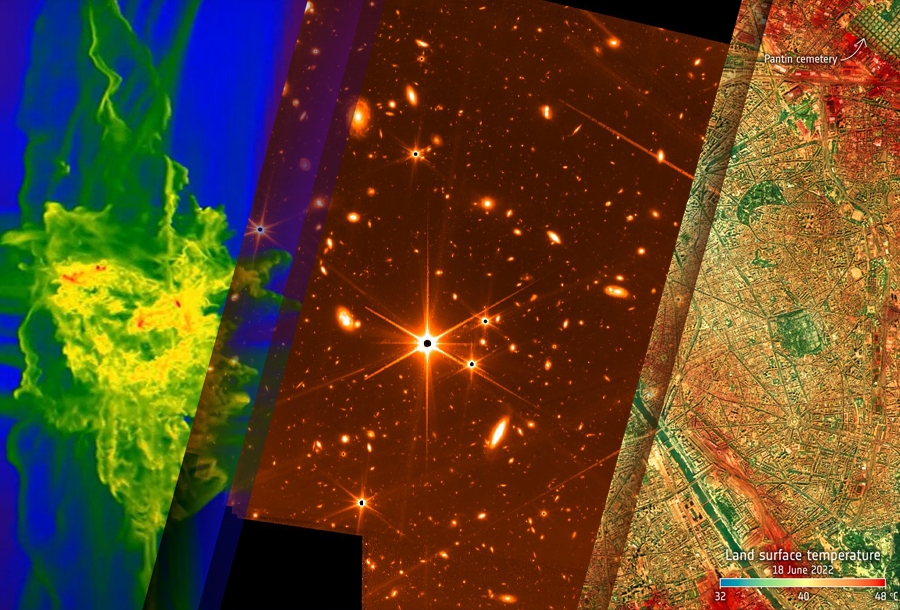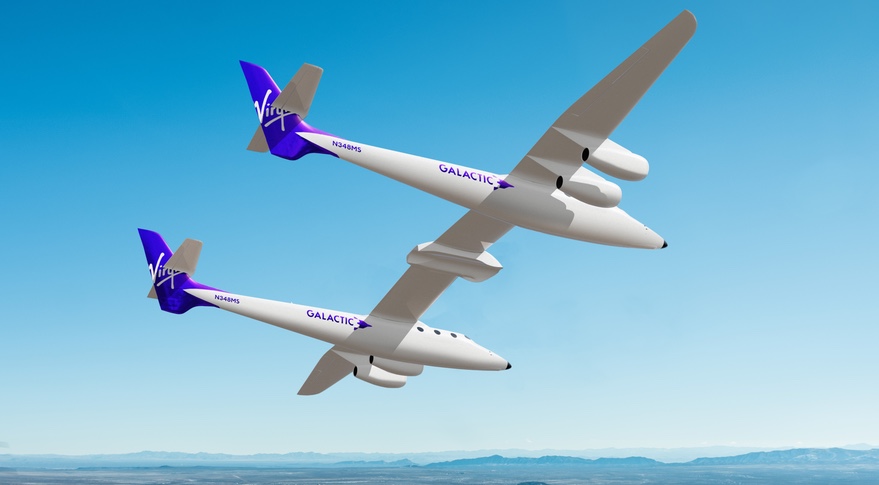Selection of the most interesting space news for breakfast: A tiny earbud will monitor the sleep of astronauts in space. The first virtual rocket simulation competitions are starting in Ukraine, and China is successfully using the “drag sail” technology to combat debris in orbit.

- Even the Webb telescope’s engineering test images manage to wow
- The first virtual rocket modeling competitions will start in Ukraine
- Scientists showed how the first quasars formed
- Virgin Galactic selects Aurora Flight Sciences to build new motherships
- Venture Orbital Systems gains millions EUR from Series A funding for their micro-launcher program
- Goodbye, space junk! Chinese engineers successfully use ‘drag sail’ technology
- Kleos Space Opens New UK Facility at Space Park Leicester
- Defense Innovation Unit selects contractors to build hybrid space network
- SpaceX Falcon 9 rocket nails launch and landing on record-tying 13th mission
- ESA takes part in the largest science fiction conference
- This Tiny Earbud Will Monitor How Astronauts Sleep in Space
- City heat extremes
Even the Webb telescope’s engineering test images manage to wow
On Wednesday evening NASA released a “test” image from the telescope that suggests the forthcoming scientific images and data will be spectacular. The release of the test photo, which NASA casually says is “among the deepest images of the Universe ever taken,” almost feels like a flex because it is so good for a throw-away engineering image.
The space agency collected the image in late May during a week-long stability test intended to demonstrate the capabilities of the telescope’s Fine Guidance Sensor. This instrument helps Webb find and lock onto astronomical targets, and it was built by the Canadian Space Agency.
The first virtual rocket modeling competitions will start in Ukraine
Noosphere Space Games online rocket modeling competition “Time to Conquer Space” has started in Ukraine. Participants will design and launch their virtual spacecraft in a simulation game, the press service of the Noosphere Association reports. Such competitions will be held in Ukraine for the first time. The competition uses an original video game – Kerbal Space Program (USA), one of the most successful space flight simulators. Participants will compete for a prize pool of USD 1,000, participation in the competition is free of charge.
Scientists showed how the first quasars formed
Researchers have created a model that shows how the first quasars could have formed less than a billion years after the Big Bang. They proved that supermassive black holes can be created by colossal gas flows.
Researchers from the University of Portsmouth have created a model that shows how quasars formed in the very early Universe. Each of these objects represents the active core of the Galaxy. At its center is a supermassive black hole. Now such objects are mainly growing due to the merging of smaller singularities.
Market News

Virgin Galactic selects Aurora Flight Sciences to build new motherships
Virgin Galactic announced it signed an agreement with a Boeing subsidiary to build two new aircraft that will be used as launch platforms for its next-generation suborbital spaceplanes. The companies did not disclose the value of the contract, but according to a filing with the U.S. Securities and Exchange Commission, the contract includes a mix of fixed-price and time-and-materials task orders, with incentives to Aurora if it completes the planes on time, under budget or with improved performance.
Venture Orbital Systems gains millions EUR from Series A funding for their micro-launcher program
Venture Orbital Systems (VOS) has shown steady progress toward the development of their orbital launcher over the past few months. To further this momentum, the company recently closed a major agreement in funding that contains decisive backing and the closing of a 10 million euros Series A funding round. This funding will be an essential factor for all the projects and activities the company must now carry out to pave the firm’s way to orbit.
Goodbye, space junk! Chinese engineers successfully use ‘drag sail’ technology
On Wednesday, the Shanghai Academy of Spaceflight Technology announced that Chinese scientists successfully unfurled a drag sail to deorbit a recently launched Long rocket. The event marked the first time such an experiment was done with a rocket.
The drag sail is a kite-like membrane that measures 25 sq meters (269 sq feet) when fully unfurled. It’s also just one-tenth the diameter of a human hair in thickness which didn’t stop it from increasing atmospheric drag and accelerating the orbital decay of the 300kg (661 pounds) rocket’s final stage.
Kleos Space Opens New UK Facility at Space Park Leicester
Kleos Space’s U.K subsidiary is setting up operations at the Space Park Leicester research hub. Kleos plans for the new UK facility to provide access to a tech community, and facilities for research, development, and manufacturing. The radio frequency (RF) data company announced the move on Wednesday.
Space Park Leicester is a project led by The University of Leicester in partnership with local authorities that space capabilities and companies dealing with satellite design and engineering, through to downstream data and its applications. AST SpaceMobile opened a headquarters at the complex last year.
Defense Innovation Unit selects contractors to build hybrid space network
The Defense Innovation Unit awarded contracts to Anduril, Aalyria Technologies, Atlas Space Operations and Enveil for a project that seeks to demonstrate a hybrid architecture where commercial, civil and military satellites can share data.
DIU, based in Silicon Valley, was created to tap technologies from the commercial market for military applications. Its hybrid space architecture project is being done in collaboration with the Space Force and the Air Force Research Laboratory.
SpaceX Falcon 9 rocket nails launch and landing on record-tying 13th mission
A Falcon 9 topped with 53 of SpaceX’s Starlink internet satellites lifted off on Thursday from Cape Canaveral Space Force Station in Florida. About 8.5 minutes after liftoff, the Falcon 9’s first stage came back to Earth for a touchdown on the SpaceX droneship Just Read the Instructions stationed in the Atlantic Ocean off the Florida coast.
Interesting
ESA takes part in the largest science fiction conference
FedCon is one of Europe’s largest science fiction conventions, its 2022 edition held earlier this month in Bonn in Germany. Actors from the many incarnations of Star Trek, as well as Star Wars, Doctor Who, and other science fiction shows met with thousands of fans.
ESA has been taking part in FedCon since 2015, with talks, panels, and a stand covering our space science, earth observation, and human exploration missions. At this year’s event, scientists and engineers from ESTEC, ESOC, and the EAC gave talks about JWST, Rosetta, mission operations, and careers with ESA.
This Tiny Earbud Will Monitor How Astronauts Sleep in Space
The smart device will travel to the ISS to measure the difference between astronauts’ sleep on Earth and in space. In order to monitor astronauts’ sleeping patterns, a group of scientists from Aarhus University in Denmark designed a small device to measure how astronauts experience sleep in space. The device is called ear-EEG (ear-ElectroEncephaloGraphy), and it can be worn on the ear similar to earphones. Once in place, the ear-EEG will monitor the astronauts’ electrical activity in the brain while they sleep. According to Aarhus University, it works by detecting very small voltage changes on the surface of the skin inside the ear, which are caused by electrical activity emanating from brain neurons.
City heat extremes
With air temperatures in excess of 10°C above the average for the time of year in parts of Europe, the United States and Asia, June 2022 has gone down as a record breaker. The fear is that these extreme early-season heatwaves are a taste of what could soon be the norm as climate change continues to take hold. For those in cities, the heat dissipates slower creating ‘urban heat islands’, which make everyday life even more of a struggle.
An instrument, carried on the International Space Station, has captured the recent land-surface temperature extremes for some European cities, including Milan, Paris and Prague.
Follow us on Twitter to get the most interesting space news in time
https://twitter.com/ust_magazine
